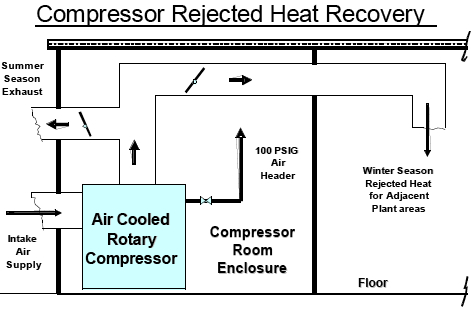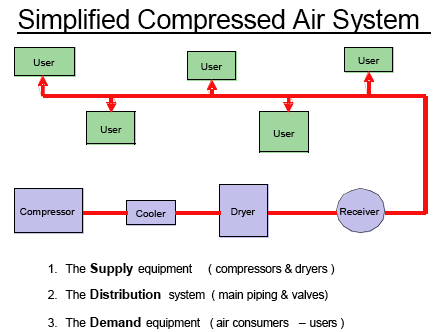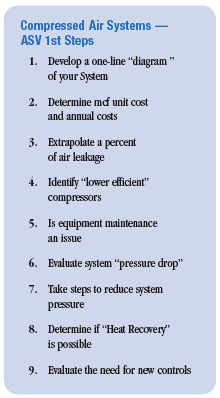An industrial manufacturing plant ( producing commercial water meters and valves ) had engaged us to conduct an ‘on-site’ Energy & Utilities Assessment of their facility. The annual ‘spend’ for electricity, natural gas, fuels and water was about \$ 2.0 million.
During a five-day visit, several opportunities were identified and delineated in lighting, HVAC, process ventilation, the water systems and energy supply contracts. However, the most significant savings were in their compressed air system.
Normal production operations ( 12 and 18 hours per day and 5 to 6 days per week ) required three of four 300 hp air-cooled rotary compressors to be running ( generally fully loaded ) at 110 to 115 psig. The foundry operations building ( with a 200,000 cfm exhaust air ventilation dust collection system ) was costing about \$ 250,000 per winter season for heating using several roof mounted natural gas-fired air make-up units. Temperatures were being controlled at 550 to 600 F to conserve costs. Cold air was being pulled in through most doors and wall openings. Comfort was not the ‘norm’.
We noted that both under-roof air compressor mechanical rooms were conveniently located outside adjacent to this High-Bay Foundry building. Thus, we recommended a heat recovery project. The compressors all ready had sound enclosures and exhaust ducts through the roof cover. Each compressor was producing about 700,000 Btuh of parasitic heat at 1400 to 1600 F. Their HVAC maintenance technician ( who had to go on the High-Bay roof in mid-winter to service the gas-fired AMUs ) was excited about this new scheme to say the least.

They installed insulated air ducts ( with diversion dampers for the Summer season ) into the sides of the Foundry building over the next few months. When winter arrived building heating savings was on the order of \$ 12,000 per month. Moreover, ambient temperatures inside the building were much improved. Employees were able to ‘shed’ their heavy jackets.
Further investigation identified that the 110 to 115 psig compressor discharge pressure was needed to maintain process cycle efficiency on the huge metal casting conveyor line that utilized four large 8” diameter x 30” long air cylinders. These cylinders required 90 psig minimum to the control valves. Due to undersized air supply piping and a small local surge tank, a 15-20 psig pressure drop was occurring in the line to the cylinders. The production superintendent was strongly opposed to lowering system pressure due to numerous process line problems over the years. It took some serious salesmanship to convince them that air system supply piping improvements could be made to work.

Piping changes and an additional local surge tank ( that they happened to have in excess ) were installed. The surge tank was located as close to the cylinders as possible. This change not only resulted in reducing the compressors to 100 psig, but also allowed shut-down one of the 300 hp units. Talk about an ‘artificial demand’ issue success!
The specific savings for that energy project was estimated at \$ 29,000 per year and compressor maintenance cost savings were also expected at 15 psig lower operating pressure. Compressor after coolers, Air Dryers and condensate trap preventive maintenance improvements accounted for an additional \$ 12,000 per year of savings.

Equipment modifications and routine maintenance activity changes were also developed and implemented to ensure that the savings ( as outlined above ) would continue. Several months after implementation, the maintenance crew continued to be quite pleased with the new operating conditions and the employees in the Foundry have improved their productivity.
Summary and Comment:
Do your compressors have heat recovery ? Have you considered this option ? What compressor discharge pressure does your facility really need? Piping system design is crucial to operating the compressors at lower pressures. Piping configuration frictional line losses can be significant. Short duration high ‘surge-flow’ conditions also can affect system pressure.
If your plant operates air compressors above 95-100 psig, you should know why and have a sound technical reason for that condition. Not only energy cost savings, but also long term reliability of the compressors would result when operating at 90 -100 psig versus units operating continually at 115 -125 psig. Most process equipment should operate reliably with 80 psig air supply to the machine manifold (with some specific exceptions such as large air cylinders, Pulse-Jet baghouses and sandblast units).
For more information, please contact Gary Wamsley, PE, CEM, JoGar Energy Services, tel: 678-977-1508, www.jogarenergy.com.




